engine SKODA SUPERB 2003 1.G / (B5/3U) Workshop Manual
[x] Cancel search | Manufacturer: SKODA, Model Year: 2003, Model line: SUPERB, Model: SKODA SUPERB 2003 1.G / (B5/3U)Pages: 259
Page 184 of 259

Driving and the Environment183
Using the systemSafetyDriving TipsGeneral MaintenanceBreakdown assistanceTechnical Data
Saving electricity
Generating electricity costs fuel.
– Switch off electrical components as soon as you no longer
need them.
When the engine is running, the alternator generates and supplies elec-
trical power. The greater the load on the alternator as a result of having a
large number of electrical components switched on, the more fuel will be
consumed for operating the alternator.
Keeping a log of your fuel consumption
If you really wish to keep a close check on your fuel consumption, it is
best to enter the figures in a logbook. This does not take much time but is
a very worthwhile exercise. It enables you to detect any change (positive
and negative) at an early stage and to take any appropriate action.
If you find that your fuel consumption is too high, you should reflect on
how, where and in what conditions you have driven the vehicle since you
last refuelled.
Environmental compatibility
Environmental protection has played a major role in the design, selection
of materials and manufacture of your new Škoda. Particular emphasis has
been paid to a number of aspects, including:
Design measures
•Joints designed to be easily detached
•Simplified disassembly due to the modular structure system
•Improved purity of different classes of materials
•Identification of all plastic parts in accordance with VDA Recommen-
dation 260
•Reduced fuel consumption and exhaust emission CO2
•Minimum fuel leakage during accidents
•Reduced noise
Choice of materials
•Extensive use of recyclable material
•Air conditioning filled with CFC-free refrigerant
•No cadmium
•No asbestos
•Reduction in the “vaporisation” of plastics
Manufacture
•Cavity protection without using solvents
•Solvent-free protection of the vehicle for transportation from the
production plant to the customer
•Use of solvent-free adhesives
•No CFCs used in the production process
•Without use of mercury
•Use of water-soluble paints
Page 185 of 259
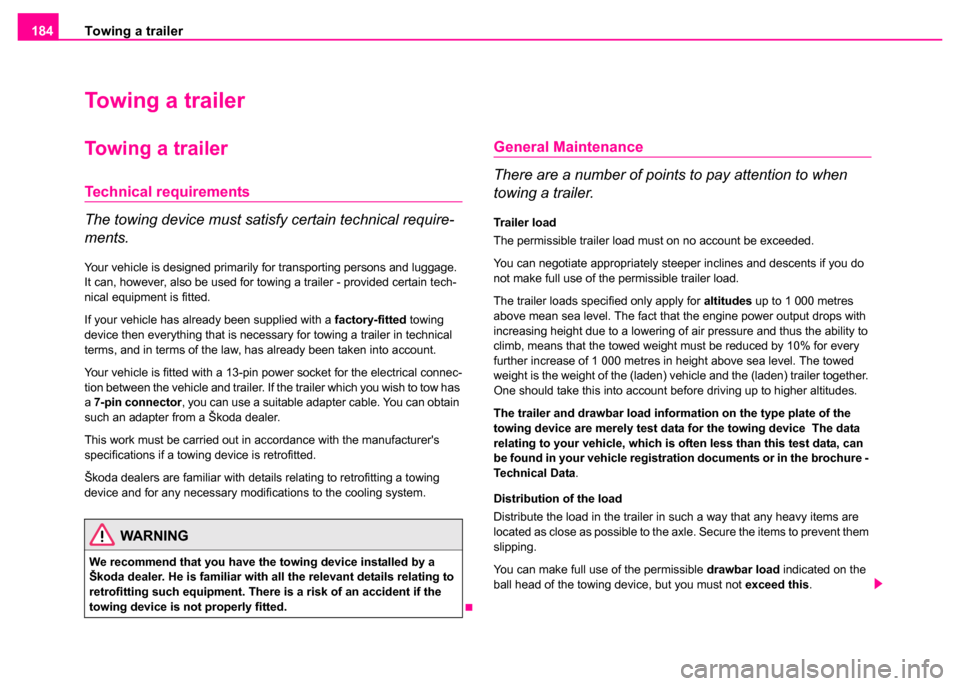
Towing a trailer
184
Towing a trailer
Towing a trailer
Technical requirements
The towing device must satisfy certain technical require-
ments.
Your vehicle is designed primarily for transporting persons and luggage.
It can, however, also be used for towing a trailer - provided certain tech-
nical equipment is fitted.
If your vehicle has already been supplied with a factory-fitted towing
device then everything that is necessary for towing a trailer in technical
terms, and in terms of the law, has already been taken into account.
Your vehicle is fitted with a 13-pin power socket for the electrical connec-
tion between the vehicle and trailer. If the trailer which you wish to tow has
a 7-pin connector , you can use a suitable adapter cable. You can obtain
such an adapter from a Škoda dealer.
This work must be carried out in accordance with the manufacturer's
specifications if a towing device is retrofitted.
Škoda dealers are familiar with details relating to retrofitting a towing
device and for any necessary modifications to the cooling system.
General Maintenance
There are a number of points to pay attention to when
towing a trailer.
Trailer load
The permissible trailer load must on no account be exceeded.
You can negotiate appropriately steeper inclines and descents if you do
not make full use of the permissible trailer load.
The trailer loads specified only apply for altitudes up to 1 000 metres
above mean sea level. The fact that the engine power output drops with
increasing height due to a lowering of air pressure and thus the ability to
climb, means that the towed weight must be reduced by 10% for every
further increase of 1 000 metres in height above sea level. The towed
weight is the weight of the (laden) vehicle and the (laden) trailer together.
One should take this into account before driving up to higher altitudes.
The trailer and drawbar load information on the type plate of the
towing device are merely test data for the towing device The data
relating to your vehicle, which is often less than this test data, can
be found in your vehicle registration documents or in the brochure -
Technical Data.
Distribution of the load
Distribute the load in the trailer in such a way that any heavy items are
located as close as possible to the axle. Secure the items to prevent them
slipping.
You can make full use of the permissible drawbar load indicated on the
ball head of the towing device, but you must not exceed this.
WARNING
We recommend that you have the towing device installed by a
Škoda dealer. He is familiar with all the relevant details relating to
retrofitting such equipment. There is a risk of an accident if the
towing device is not properly fitted.
Page 187 of 259
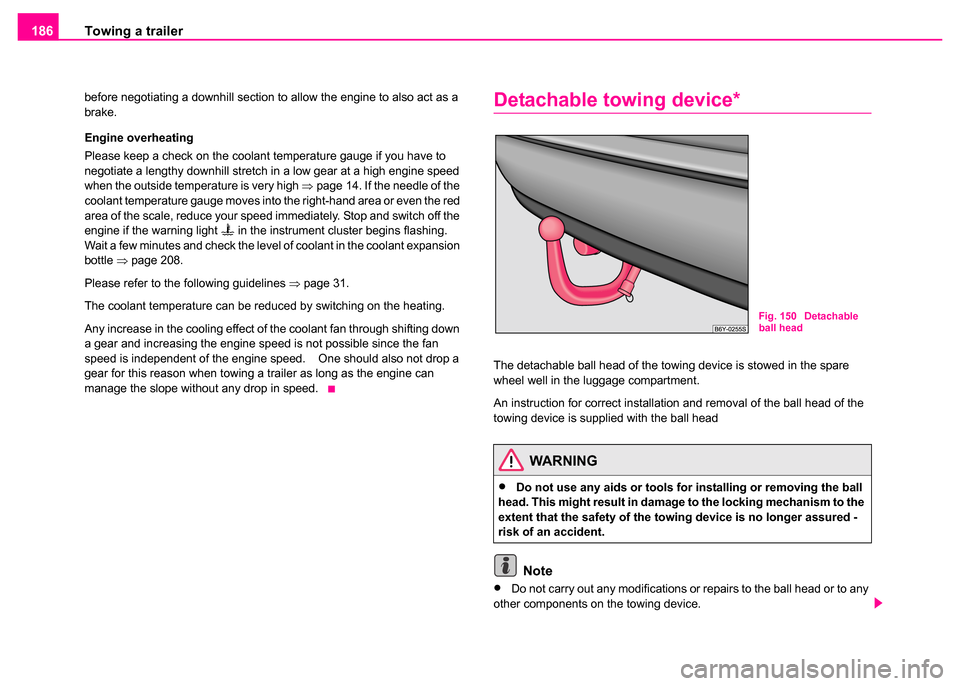
Towing a trailer
186
before negotiating a downhill section to allow the engine to also act as a
brake.
Engine overheating
Please keep a check on the coolant temperature gauge if you have to
negotiate a lengthy downhill stretch in a low gear at a high engine speed
when the outside temperature is very high ⇒page 14. If the needle of the
coolant temperature gauge moves into the right-hand area or even the red
area of the scale, reduce your speed immediately. Stop and switch off the
engine if the warning light
in the instrument cluster begins flashing.
Wait a few minutes and check the level of coolant in the coolant expansion
bottle ⇒page 208.
Please refer to the following guidelines ⇒page 31.
The coolant temperature can be reduced by switching on the heating.
Any increase in the cooling effect of the coolant fan through shifting down
a gear and increasing the engine speed is not possible since the fan
speed is independent of the engine speed. One should also not drop a
gear for this reason when towing a trailer as long as the engine can
manage the slope without any drop in speed.
Detachable towing device*
The detachable ball head of the towing device is stowed in the spare
wheel well in the luggage compartment.
An instruction for correct installation and removal of the ball head of the
towing device is supplied with the ball head
Note
•Do not carry out any modifications or repairs to the ball head or to any
other components on the towing device.
WARNING
•Do not use any aids or tools for installing or removing the ball
head. This might result in damage to the locking mechanism to the
extent that the safety of the towing device is no longer assured -
risk of an accident.
Fig. 150 Detachable
ball head
Page 197 of 259
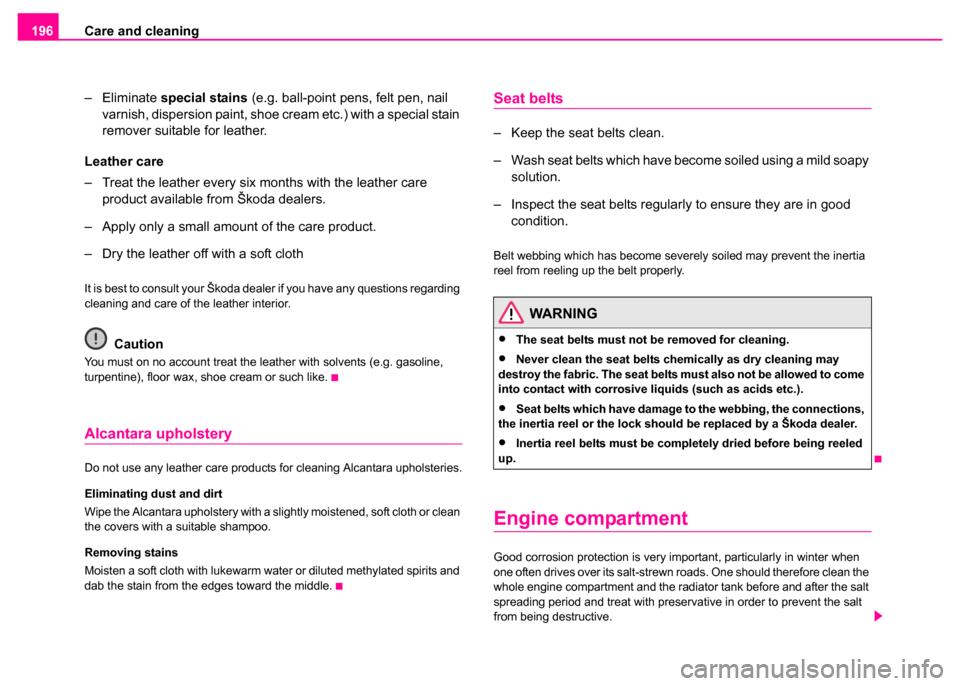
Care and cleaning
196
–Eliminate special stains (e.g. ball-point pens, felt pen, nail
varnish, dispersion paint, shoe cream etc.) with a special stain
remover suitable for leather.
Leather care
– Treat the leather every six months with the leather care product available from Škoda dealers.
– Apply only a small amount of the care product.
– Dry the leather off with a soft cloth
It is best to consult your Škoda dealer if you have any questions regarding
cleaning and care of the leather interior.
Caution
You must on no account treat the leather with solvents (e.g. gasoline,
turpentine), floor wax, shoe cream or such like.
Alcantara upholstery
Do not use any leather care products for cleaning Alcantara upholsteries.
Eliminating dust and dirt
Wipe the Alcantara upholstery with a slightly moistened, soft cloth or clean
the covers with a suitable shampoo.
Removing stains
Moisten a soft cloth with lukewarm water or diluted methylated spirits and
dab the stain from the edges toward the middle.
Seat belts
– Keep the seat belts clean.
– Wash seat belts which have become soiled using a mild soapy solution.
– Inspect the seat belts regularly to ensure they are in good condition.
Belt webbing which has become severely soiled may prevent the inertia
reel from reeling up the belt properly.
Engine compartment
Good corrosion protection is very important, particularly in winter when
one often drives over its salt-strewn roads. One should therefore clean the
whole engine compartment and the radiator tank before and after the salt
spreading period and treat with preservative in order to prevent the salt
from being destructive.
WARNING
•The seat belts must not be removed for cleaning.
•Never clean the seat belts chemically as dry cleaning may
destroy the fabric. The seat belts must also not be allowed to come
into contact with corrosive liquids (such as acids etc.).
•Seat belts which have damage to the webbing, the connections,
the inertia reel or the lock should be replaced by a Škoda dealer.
•Inertia reel belts must be completely dried before being reeled
up.
Page 198 of 259

Care and cleaning197
Using the systemSafetyDriving TipsGeneral MaintenanceBreakdown assistanceTechnical Data
Skoda dealers have the cleaning agents and preservatives recommended
by the manufacturer and also the required equipment.
Caution
•Engine cleaning may be only be undertaken when the ignition is off.
•It is recommended to cover the generator before washing the engine
compartment.
For the sake of the environment
The dirty water produced by washing the engine has washed away petrol,
and residues of grease and oil and should therefore be cleaned by an oil
separator. This is why engine washing should only be undertaken in a
garage or at a fueling station (when these are fitted with the required
equipment).
WARNING
It is necessary to observe the guidelines given in the chapter
before working on the engine compartment ⇒page 203.
Page 199 of 259
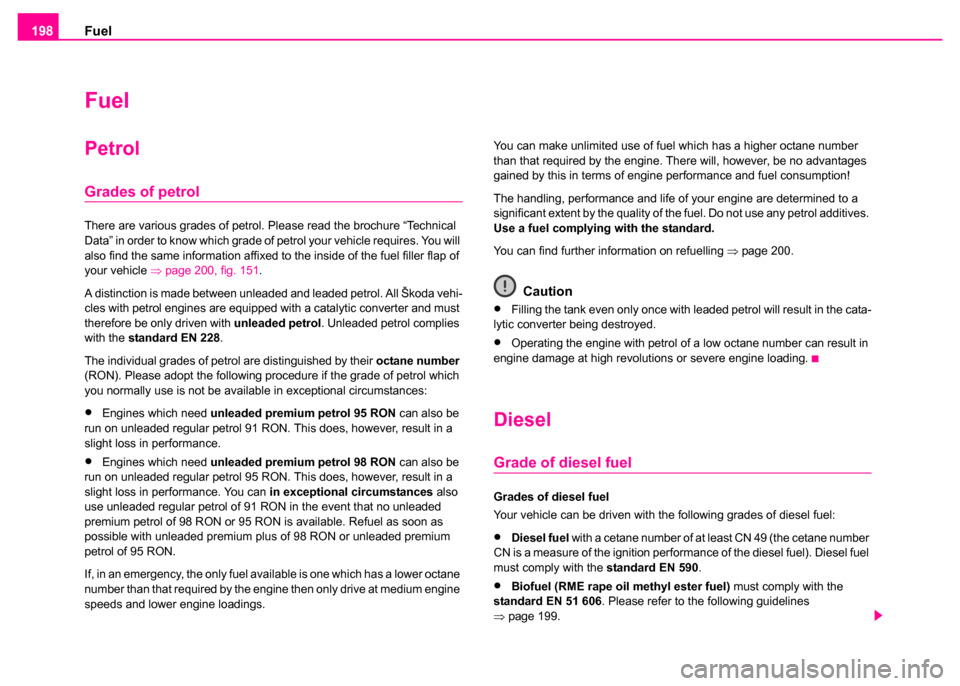
Fuel
198
Fuel
Petrol
Grades of petrol
There are various grades of petrol. Please read the brochure “Technical
Data” in order to know which grade of petrol your vehicle requires. You will
also find the same information affixed to the inside of the fuel filler flap of
your vehicle ⇒page 200, fig. 151 .
A distinction is made between unleaded and leaded petrol. All Škoda vehi-
cles with petrol engines are equipped with a catalytic converter and must
therefore be only driven with unleaded petrol. Unleaded petrol complies
with the standard EN 228 .
The individual grades of petrol are distinguished by their octane number
(RON). Please adopt the following procedure if the grade of petrol which
you normally use is not be available in exceptional circumstances:
•Engines which need unleaded premium petrol 95 RON can also be
run on unleaded regular petrol 91 RON. This does, however, result in a
slight loss in performance.
•Engines which need unleaded premium petrol 98 RON can also be
run on unleaded regular petrol 95 RON. This does, however, result in a
slight loss in performance. You can in exceptional circumstances also
use unleaded regular petrol of 91 RON in the event that no unleaded
premium petrol of 98 RON or 95 RON is available. Refuel as soon as
possible with unleaded premium plus of 98 RON or unleaded premium
petrol of 95 RON.
If, in an emergency, the only fuel available is one which has a lower octane
number than that required by the engine then only drive at medium engine
speeds and lower engine loadings. You can make unlimited use of fuel which has a higher octane number
than that required by the engine. There will, however, be no advantages
gained by this in terms of engine performance and fuel consumption!
The handling, performance and life of your engine are determined to a
significant extent by the quality of the fuel. Do not use any petrol additives.
Use a fuel complying with the standard.
You can find further information on refuelling
⇒page 200.
Caution
•Filling the tank even only once with leaded petrol will result in the cata-
lytic converter being destroyed.
•Operating the engine with petrol of a low octane number can result in
engine damage at high revolutions or severe engine loading.
Diesel
Grade of diesel fuel
Grades of diesel fuel
Your vehicle can be driven with the following grades of diesel fuel:
•Diesel fuel with a cetane number of at least CN 49 (the cetane number
CN is a measure of the ignition performance of the diesel fuel). Diesel fuel
must comply with the standard EN 590 .
•Biofuel (RME rape oil methyl ester fuel) must comply with the
standard EN 51 606 . Please refer to the following guidelines
⇒ page 199.
Page 200 of 259
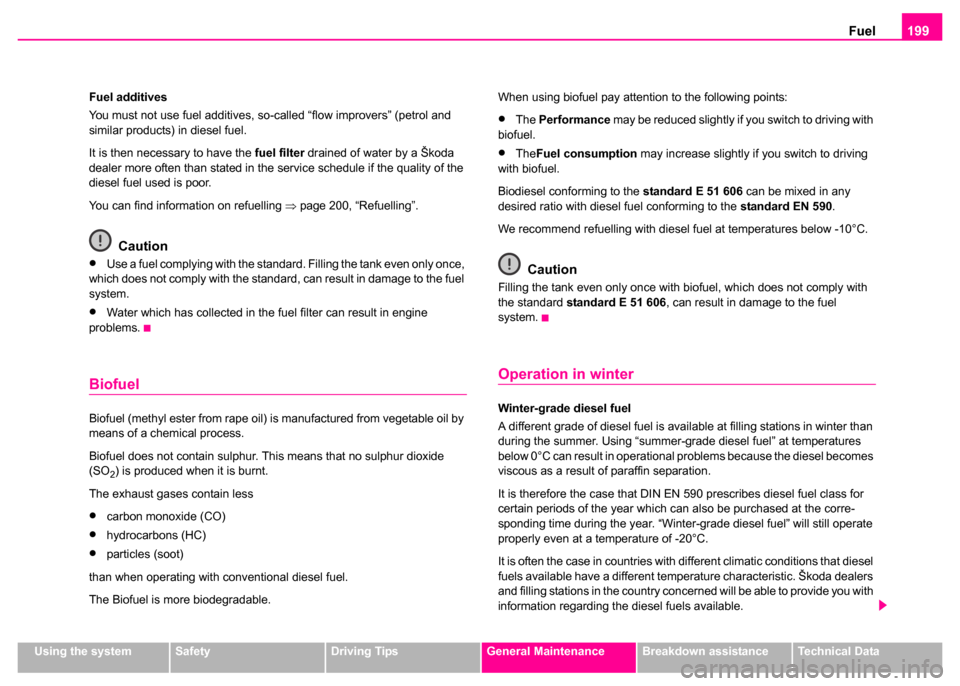
Fuel199
Using the systemSafetyDriving TipsGeneral MaintenanceBreakdown assistanceTechnical Data
Fuel additives
You must not use fuel additives, so-called “flow improvers” (petrol and
similar products) in diesel fuel.
It is then necessary to have the
fuel filter drained of water by a Škoda
dealer more often than stated in the service schedule if the quality of the
diesel fuel used is poor.
You can find information on refuelling ⇒page 200, “Refuelling”.
Caution
•Use a fuel complying with the standard. Filling the tank even only once,
which does not comply with the standard, can result in damage to the fuel
system.
•Water which has collected in the fuel filter can result in engine
problems.
Biofuel
Biofuel (methyl ester from rape oil) is manufactured from vegetable oil by
means of a chemical process.
Biofuel does not contain sulphur. This means that no sulphur dioxide
(SO
2) is produced when it is burnt.
The exhaust gases contain less
•carbon monoxide (CO)
•hydrocarbons (HC)
•particles (soot)
than when operating with conventional diesel fuel.
The Biofuel is more biodegradable. When using biofuel pay attention to the following points:
•The
Performance may be reduced slightly if you switch to driving with
biofuel.
•The Fuel consumption may increase slightly if you switch to driving
with biofuel.
Biodiesel conforming to the standard E 51 606 can be mixed in any
desired ratio with diesel fuel conforming to the standard EN 590.
We recommend refuelling with diesel fuel at temperatures below -10°C.
Caution
Filling the tank even only once with biofuel, which does not comply with
the standard standard E 51 606 , can result in damage to the fuel
system.
Operation in winter
Winter-grade diesel fuel
A different grade of diesel fuel is available at filling stations in winter than
during the summer. Using “summer-grade diesel fuel” at temperatures
below 0°C can result in operational problems because the diesel becomes
viscous as a result of paraffin separation.
It is therefore the case that DIN EN 590 prescribes diesel fuel class for
certain periods of the year which can also be purchased at the corre-
sponding time during the year. “Winter-grade diesel fuel” will still operate
properly even at a temperature of -20°C.
It is often the case in countries with different climatic conditions that diesel
fuels available have a different temperature characteristic. Škoda dealers
and filling stations in the country concerned will be able to provide you with
information regarding the diesel fuels available.
Page 202 of 259

Fuel201
Using the systemSafetyDriving TipsGeneral MaintenanceBreakdown assistanceTechnical Data
•Vehicles fitted with catalytic converter should never be allowed to let
the fuel tank to run completely empty. An irregular supply of fuel to the
engine can result in misfiring and unburnt fuel may get into the exhaust
system, which may result in overheating and damage to the catalytic
converter.
For the sake of the environment
The fuel tank is full just as soon as the pump nozzle switches off for the
first time, provided the nozzle has been operated properly. You should not
continue refuelling - otherwise the expansion chamber in the fuel tank will
also be filled with fuel. Fuel might flow out of the tank when it heats up.
Emergency release of fuel filler flap
If the electric lock is faulty, you can also unlock the fuel filler flap
manually. – Open the boot lid/luggage compartment door.
– Unscrew the clip attaching the right-hand side trim panel and
pull the trim panel off the body.
– Pull on the loop in direction of arrow in order to unlock the fuel filler flap ⇒fig. 152 .
Fig. 152 Luggage
compartment: Emer-
gency release of fuel
filler flap
WARNING
Reel up the belt webbing once again until it is fitted snugly against
the child seat.
Page 203 of 259
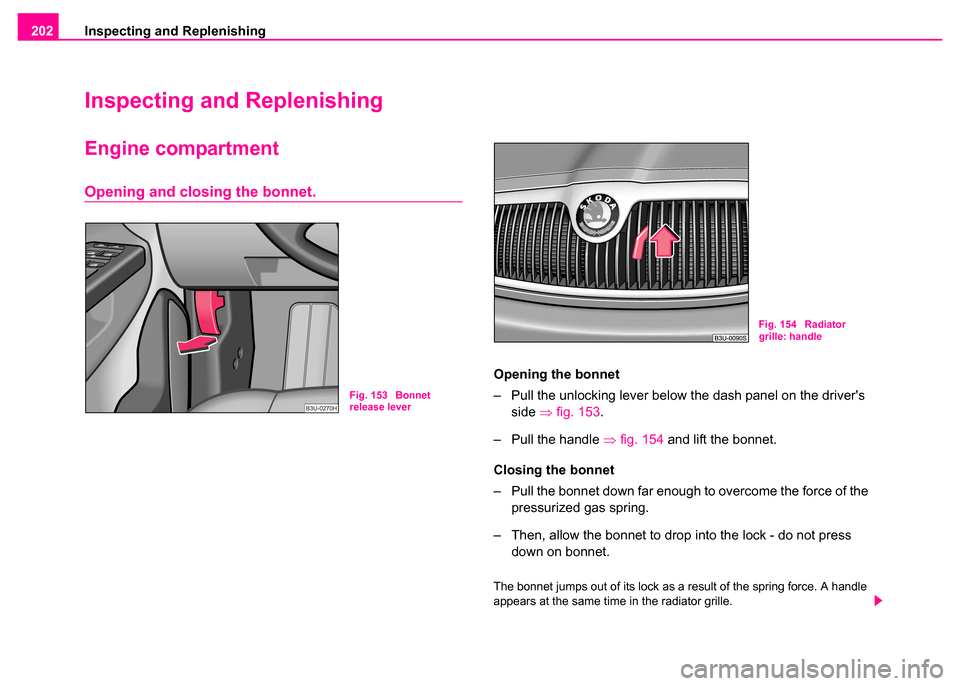
Inspecting and Replenishing
202
Inspecting and Replenishing
Engine compartment
Opening and closing the bonnet.
Opening the bonnet
– Pull the unlocking lever below the dash panel on the driver's
side ⇒fig. 153 .
– Pull the handle ⇒fig. 154 and lift the bonnet.
Closing the bonnet
– Pull the bonnet down far enough to overcome the force of the pressurized gas spring.
– Then, allow the bonnet to drop into the lock - do not press down on bonnet.
The bonnet jumps out of its lock as a result of the spring force. A handle
appears at the same time in the radiator grille.
Fig. 153 Bonnet
release lever
Fig. 154 Radiator
grille: handle
Page 204 of 259
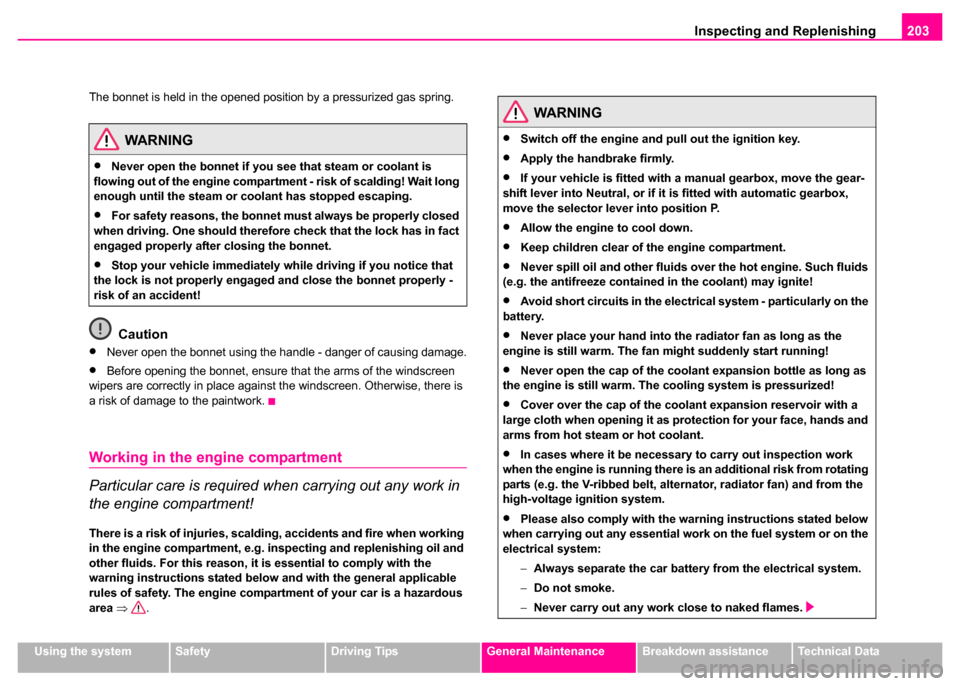
Inspecting and Replenishing203
Using the systemSafetyDriving TipsGeneral MaintenanceBreakdown assistanceTechnical Data
The bonnet is held in the opened position by a pressurized gas spring.
Caution
•Never open the bonnet using the handle - danger of causing damage.
•Before opening the bonnet, ensure that the arms of the windscreen
wipers are correctly in place against the windscreen. Otherwise, there is
a risk of damage to the paintwork.
Working in the en gine compartment
Particular care is required when carrying out any work in
the engine compartment!
There is a risk of injuries, scalding , accidents and fire when working
in the engine compartment, e.g. inspecting and replenishing oil and
other fluids. For this reason, it is essential to comply with the
warning instructions st ated below and with the general applicable
rules of safety. The engine compartment of your car is a hazardous
area ⇒ .
WARNING
•Never open the bonnet if you see that steam or coolant is
flowing out of the engine compartmen t - risk of scalding! Wait long
enough until the steam or coolant has stopped escaping.
•For safety reasons, the bonnet must always be properly closed
when driving. One should therefore check that the lock has in fact
engaged properly after closing the bonnet.
•Stop your vehicle immediately wh ile driving if you notice that
the lock is not properly engaged and close the bonnet properly -
risk of an accident!
WARNING
•Switch off the engine and pull out the ignition key.
•Apply the handbrake firmly.
•If your vehicle is fitted with a manual gearbox, move the gear-
shift lever into Neutral, or if it is fitted with automatic gearbox,
move the selector lever into position P.
•Allow the engine to cool down.
•Keep children clear of the engine compartment.
•Never spill oil and other fluids over the hot engine. Such fluids
(e.g. the antifreeze contained in the coolant) may ignite!
•Avoid short circuits in the electrical system - particularly on the
battery.
•Never place your hand into the radiator fan as long as the
engine is still warm. The fan might suddenly start running!
•Never open the cap of the coolant expansion bottle as long as
the engine is still warm. The cooling system is pressurized!
•Cover over the cap of the coolant expansion reservoir with a
large cloth when opening it as protection for your face, hands and
arms from hot steam or hot coolant.
•In cases where it be necessary to carry out inspection work
when the engine is running there is an additional risk from rotating
parts (e.g. the V-ribbed belt, alternator, radiator fan) and from the
high-voltage ignition system.
•Please also comply with the warning instructions stated below
when carrying out any essential work on the fuel system or on the
electrical system:
−Always separate the car battery from the electrical system.
− Do not smoke.
− Never carry out any work close to naked flames.